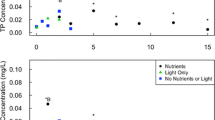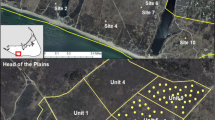Abstract
Both vertebrate herbivores and fire have long been known to have dramatic and important effects on wetland vegetation. However, the interactive effects of burning and herbivory have received less attention. In this study, conducted in the coastal marshes of the Pearl River Basin in Louisiana, USA, both the effects of herbivory and fire as well as the interaction between these effects were examined in three marsh community types:Sagittaria lancifolia, Panicum virgatum, andSpartina patens. At five sites for each of the three community types, the effects of burning and fencing to exclude herbivores were determined over two years.
Results showed that total biomass was reduced by burning but increased by fencing, with no interactive effects on total biomass. Species density (the number of species per unit area) was enhanced in plots that were both burned and fenced.Spartina patens was an important component in all three communities. Cover estimates indicated thatS. patens responded to burning and fencing differently from the other dominant species. In thePanicum virgatum community,P. virgatum cover was enhanced by burning and fencing whileS. patens cover was reduced. In theSagittaria lancifolia community,S. lancifolia andVigna luteola were enhanced by burning and fencing whileS. patens was reduced. In theS. patens community,Scirpus americanus was enhanced by fencing, but burning had no significant effect on cover of either dominant species. These and other data are generally consistent with the hypothesis that herbivory favorsS. patens while burning favors other dominant species. Thus, the relative effects of fire and herbivory have an influence (along with other factors such as salinity) on the dominance ofS. patens in coastal marshes.
Similar content being viewed by others
Literature Cited
Adams, W.H., 1956. Ecological studies of coastal marsh in the vicinity of Price Lake, Rockefeller Refuge, Cameron Parish, Louisiana. M.S. Thesis. Louisiana State University, Baton Rouge, LA, USA.
Bazely, D.R. and R.L. Jefferies. 1986. Changes in the composition and standing crop of saltmarsh communities in response to removal of a grazer. Journal of Ecology 74:693–706.
Bond, W. J. and B. W. van Wilgen. 1996. Fire and Plants. Chapman and Hall Publishers, New York, NY, USA.
Brewer, J.S. and J.B. Grace. 1990. Plant community structure in an oligehaline tidal marsh. Vegetatio 90:93–107.
Chabreck, R.H. 1959. A study of nutria exclosures in southwest Louisiana. Final Report to the Louisiana Wildlife and Fisheries Commission, Baton Rouge, LA, USA.
Chabreck, R.H. 1982. Effect of burn date and regrowth rate ofScirpus olneyi andSpartina patens. Proceedings of the Annual Conference of Southeastern Association of Fish and Wildlife Agencies 35:201–210.
Chabreck, R.H. 1988. Coastal Marshes. University of Minnesota Press, Minneapolis, MN, USA.
Fuller, D.A., C.E. Sasser, W.B. Johnson, and J.G. Gosselink. 1985. The effects of herbivory on vegetation on islands in Atchafalaya Bay, Louisiana. Wetlands 4:105–114.
Grace J.B. and M.A. Ford. 1996. The potential impact of herbivores on the susceptibility of marsh plantSagittaria lancifolia to saltwater intrusion in coastal wetlands. Estuaries 19:13–20.
Grace, J.B., J. Keough, and G.R. Guntenspergen. 1992. Size bias in traditional analyses of substitutive competition experiments. Oecologia 90:429–434.
Grace, J.B., G.R. Guntenspergen, and J. Keough. 1993. The examination of a competition matrix for transitivity and intransitive loops. Oikos 68:91–98.
Grace, J.B. and B.H. Pugesek. 1997. A structural equation model of plant species richness and its application to a coastal wetland. American Naturalist 149:436–460.
Hoffpanir, C.M. 1961. Methods of Measuring and Determining the Effects of Marsh Fires. M.S. Thesis. Louisiana State University, Baton Rouge, LA, USA
Kays, C.E. 1956. An Ecological Study with Emphasis on Nutria (Myocastor coypu) in the Vicinity of Price Lake, Rockefeller Refuge, Cameron Parish, Louisiana. M.S. Thesis. Louisiana State University, Baton Rouge, LA, USA.
Kirby, R.E., S.J. Lewis, and T.N. Sexon. 1988. Fire in North American wetland ecosystems and fire-wildlife relations: an annotated bibliography. U.S. Fish and Wildlife Service, Office of Biological Services, Washington, DC, USA. FWS/OBS-88/1.
Linscombe, G., N. Kinler, and V. Wright. 1981. Nutria population density and vegetative changes in brackish marsh in coastal Louisiana, p. 129–141.In: J.A. Chapman and A. Pursley (eds.) World-wide Furbearers Conference Proceedings Volume 1, Frostburg, Maryland, USA.
Lowery, G.H. Jr. 1981. The Mammals of Louisiana and its a Adjacent Waters. Louisiana State University Press, Baton Rouge, LA, USA.
Lynch, J.J. 1941. The place of burning in management of the Gulf Coast Wildlife refuges. Journal of Wildlife Management 5:454–457.
Lynch, J.J., T. O’Neil, and D.W. Day. 1947. Management Significance of Damage by Geese and Muskrat to Gulf Coast Marshes, Journal of Wildlife Management 11:50–76.
Mendelssohn, I.A., K.L. McKee and R. Chabreck. 1988. The influence of burning on the growth response ofScirpus olneyi to saltwater intrusion and subsidence, Final report to Board of Regents. Louisiana State University, Baton Rouge, LA, USA.
Mitsch, W.J. and J.G. Gosselink. 1986. Wetlands. Van Nostrand Reinhold Company, New York, NY, USA.
Myers, R.S., G.P. Shaffer, and D.W. Llewellyn. 1995. Baldcypress (Taxodium distichum (L.) Rich.) restoration in southeast Louisiana: The relative effects of herbivory, flooding, competition, and macronutrient. Wetlands 15:141–148.
Nyman, J.A. and R.H. Chabreck. 1995. Fire in coastal marshes: history and recent concerns. p. 134–141.In S.I. Cerulean and R.T. Engstrom (eds.) Fire in wetlands: a management perspective. Proceedings of the Tall Timbers Ecology Conference, Number 19, Tall Timbers Research Station, Tallahassee, FL, USA.
Nyman, J.A., R.H. Chabreck, and N.W. Kinler. 1993. Some effects of herbivory and 30 years of weir management on emergent vegetation in brackish marsh. Wetlands 13:165–175.
O’Neil, T. 1949. The muskrat in the Louisiana coastal marshes. Louisiana Department of Wildlife and Fisheries, New Orleans, LA, USA
SAS Institute, Inc. 1988. SAS/STAT user’s guide, release 6.03 edition. SAS Institute, Cary, NC, USA.
Schmalzer, P.A., C.R. Hinkle and J.L. Mailander. 1991. Changes in community composition and biomass inJuncus roemarianus Scheele andSpartina bakeri Merr. marshes one year after a fire. Wetlands 11:67–6.
Shaffer, G.P., C.E. Sasser, J.G. Gosselink, and M. Rejmanek. 1992. Vegetation dynamics in the emerging Atchafalaya Delta, Louisiana, USA. Journal of Ecology 80:667–687.
Smith, L.M. and J.A. Kadlec. 1985. Fire and herbivory in a Great Salt Lake Marsh. Ecology 66:259–265.
Taylor, K.L., J.B. Grace, G.R. Guntenspergen and A.L. Foote. 1994. The interactive effects of herbivory and fire on an oligohaline marsh, Little Lake, Louisiana, USA. Wetlands 14:82–87.
Taylor, K.L. and J.B. Grace. 1995. The effects of vertebrate herbivory on plant community structure in the coastal marshes of the Pearl River, Louisiana, USA. Wetlands 15:68–73.
Taylor, K.L., J.B. Grace and B.D. Marx. 1997. The effects of herbivory on neighbor interactions along a coastal marsh gradient. American Journal of Botany 84:709–715.
Vogel, R.J. 1977. The ecological factors that produce perturbation-dependent ecosystems.In J. Cairns, Jr. (ed.) The Recovery Process in Damaged Ecosystems. Ann Arbor Science, Ann Arbor, MI, USA.
Whelan, R.J. 1995. The Ecology of Fire. Cambridge University Press, Cambridge, United Kingdom.
Wright, H.A. and A.W. Bailey. 1982. Fire Ecology. Wiley Publishers, New York, NY, USA.
Yoccoz, N.G. 1991. Use, overuse and misuse of significance tests in evolutionary biology and ecology. Bulletin of the Ecological Society of America 72:106–111.
Author information
Authors and Affiliations
Rights and permissions
About this article
Cite this article
Ford, M.A., Grace, J.B. The interactive effects of fire and herbivory on a coastal marsh in Louisiana. Wetlands 18, 1–8 (1998). https://doi.org/10.1007/BF03161437
Received:
Revised:
Accepted:
Issue Date:
DOI: https://doi.org/10.1007/BF03161437




